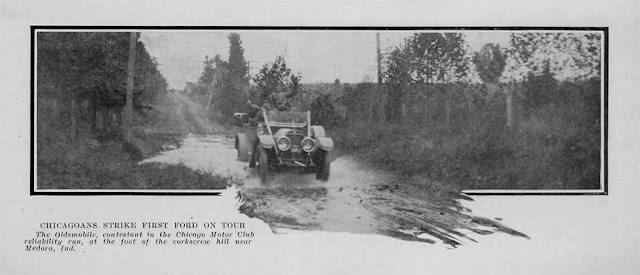 |
| Postcard of Sig Haugdahl and the Wisconsin Special - from the author's collection |
Sigurd Olson Haugdahl’s story begins upon his arrival in the United States at the age of 19. Making his home with an uncle in Minnesota, he’s soon setting speed records on ice with a Indian powered “skimobile”. By 1915, the International Motor Contest Association (IMCA) is formed and J Alex Sloan quickly emerges as their leading promoter. Sloan had an emerging star in Haugdahl and the two are seen in exhibition races and setting track speed records across the mid-west through the late teens.
It was probably Sloan’s idea to go to Daytona Beach and challenge Tommy Milton’s record run of 156 mph in 1920. Milton had broken Ralph DePalma’s run of 149 mph in the Packard “905” Special the year prior. However, it seems clear that it was Sig who built the car for the job - The Wisconsin Special.
Named the Wisconsin Special due to its use of a Wisconsin aviation engine, the engine featured six-cylinders and roughly 250 horsepower. The Motor Age of November 20, 1922 reports that the engine is made of aluminum with magnesium alloy pistons and dual carburetors. They go on to report that it has a displacement of 764 cubic inches and weighs 610 pounds with a maximum 2667 rpm.
Sig was focused on three key factors for his racing special: first, he wanted to reduce drag by streamlining the car and lowering its center of gravity; second, he looked to reduce weigh by doing away with the clutch and transmission – it was direct drive; and finally, he paid great attention to balancing the wheels and tires. Popular Science of August 1924 reported that “The driving strain at the terrific speed the car develops is so great that Haugdahl carries a cigar in his month as a cushion for his teeth. One time he forgot that his cigar was lighted. When speeding at “only” about 120 miles per hour, he turned his head slightly. The wind blew the cigar into a flame and burned it to his face in an instant nearly causing him to wreck the car.”
 |
| Postcard of Sig Haugdahl and the Wisconsin Special - from the author's collection |
Sloan and the IMCA were prepared for the record run with observers and timing equipment at hand. After a couple runs and adjustments, Haugdahl and the Wiconsin Special set a new three-mile-a-minute record of 180.27 mph – covering the mile in 19.97 seconds.
Sloan followed up the event with much press and the Wisconsin Special was taken on the circuit to fairs and festivals throughout the country. The car survives to this day. Sig Haugdahl would upset Fred Horey to take the IMCA national championship in 1927 and hold on to it for the next five years.
As for Sig Haugdahl, he would go on to create a landmark rocket powered car and organize the first Daytona Beach stock car race, inspiring a guy named Bill France to organize a racing series we call NASCAR.
 |
| Popular Science July 22, 1922 |














